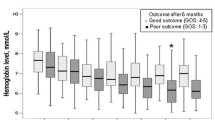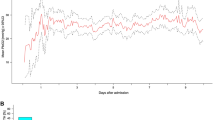Abstract
Background
We sought to determine the association between early fluid balance and neurological/vital outcome of patients with subarachnoid hemorrhage.
Methods
Hospital admission, imaging, ICU and outcome data were retrospectively collected from the medical records of adult patients with aneurysmal SAH admitted to a level-1 trauma and stroke referral center during a 5-year period. Two groups were identified based on cumulative fluid balance by ICU day 3: (i) patients with a positive fluid balance (n = 221) and (ii) patients with even or negative fluid balance (n = 135). Multivariable logistic regression was used to adjust for age, Hunt-Hess and Fisher scores, mechanical ventilation and troponin elevation (>0.40 ng/ml) at ICU admission. The primary outcome was a composite of hospital mortality or new stroke.
Results
Patients with positive fluid balance had worse admission GCS and Hunt-Hess score, and by ICU day 3 had cumulatively received more IV fluids, but had less urine output when compared with the negative fluid balance group. There was no difference in the odds of hospital death or new stroke (adjusted OR: 1.47, 95%CI: 0.85, 2.54) between patients with positive and negative fluid balance. However, positive fluid balance was associated with increased odds of TCD vasospasm (adjusted OR 2.25, 95%CI: 1.37, 3.71) and prolonged hospital length of stay.
Conclusions
Although handling of IV fluid administration was not an independent predictor of mortality or new stroke, patients with early positive fluid balance had worse clinical presentation and had greater resource use during the hospital course.
Similar content being viewed by others
References
Kassell NF, Boarini DJ, Adams HP Jr, et al. Overall management of ruptured aneurysm: comparison of early and late operation. Neurosurgery. 1981;9(2):120–8.
Rosenwasser RH, Delgado TE, Buchheit WA, et al. Control of hypertension and prophylaxis against vasospasm in cases of subarachnoid hemorrhage: a preliminary report. Neurosurgery. 1983;12(6):658–61.
Lennihan L, Mayer SA, Fink ME, et al. Effect of hypervolemic therapy on cerebral blood flow after subarachnoid hemorrhage: a randomized controlled trial. Stroke. 2000;31(2):383–91.
Vermeij FH, Hasan D, Bijvoet HW, et al. Impact of medical treatment on the outcome of patients after aneurysmal subarachnoid hemorrhage. Stroke. 1998;29(5):924–30.
Yano K, Kuroda T, Tanabe Y, et al. Preventive therapy against delayed cerebral ischaemia after aneurysmal subarachnoid haemorrhage: trials of thromboxane A2 synthetase inhibitor and hyperdynamic therapy. Acta Neurochir (Wien). 1993;125(1–4):15–9.
Treggiari MM, Walder B, Suter PM, et al. Systematic review of the prevention of delayed ischemic neurological deficits with hypertension, hypervolemia, and hemodilution therapy following subarachnoid hemorrhage. J Neurosurg. 2003;98(5):978–84.
Treggiari MM, Deem S. Which H is the most important in triple-H therapy for cerebral vasospasm? Curr Opin Crit Care. 2009;15(2):83–6.
Dankbaar JW, Slooter AJ, Rinkel GJ, et al. Effect of different components of triple-H therapy on cerebral perfusion in patients with aneurysmal subarachnoid haemorrhage: a systematic review. Crit Care. 2010;14(1):R23.
Muench E, Horn P, Bauhuf C, et al. Effects of hypervolemia and hypertension on regional cerebral blood flow, intracranial pressure, and brain tissue oxygenation after subarachnoid hemorrhage. Crit Care Med. 2007;35(8):1844–51. Quiz 1852.
Origitano TC, Wascher TM, Reichman OH, et al. Sustained increased cerebral blood flow with prophylactic hypertensive hypervolemic hemodilution (“triple-H” therapy) after subarachnoid hemorrhage. Neurosurgery. 1990;27(5):729–39. Discussion 739–740.
Raabe A, Beck J, Keller M, et al. Relative importance of hypertension compared with hypervolemia for increasing cerebral oxygenation in patients with cerebral vasospasm after subarachnoid hemorrhage. J Neurosurg. 2005;103(6):974–81.
Hoff RG, van Dijk GW, Algra A, et al. Fluid balance and blood volume measurement after aneurysmal subarachnoid hemorrhage. Neurocrit Care. 2008;8(3):391–7.
Treggiari MM, Walder B, Suter PM, et al. Systematic review of the prevention of delayed ischemic neurological deficits with hypertension, hypervolemia, and hemodilution therapy following subarachnoid hemorrhage. J Neurosurg. 2003;98:978–84.
Solenski NJ, Haley EC Jr, Kassell NF, et al. Medical complications of aneurysmal subarachnoid hemorrhage: a report of the multicenter, cooperative aneurysm study. Participants of the Multicenter Cooperative Aneurysm Study. Crit Care Med. 1995;23(6):1007–17.
Chandy D, Sy R, Aronow WS, et al. Hyponatremia and cerebrovascular spasm in aneurysmal subarachnoid hemorrhage. Neurol India. 2006;54(3):273–5.
Brimioulle S, Orellana-Jimenez C, Aminian A, et al. Hyponatremia in neurological patients: cerebral salt wasting versus inappropriate antidiuretic hormone secretion. Intensive Care Med. 2008;34(1):125–31.
Audibert G, Steinmann G, de Talance N, et al. Endocrine response after severe subarachnoid hemorrhage related to sodium and blood volume regulation. Anesth Analg. 2009;108(6):1922–8.
Yamakami I, Isobe K, Yamaura A. Effects of intravascular volume expansion on cerebral blood flow in patients with ruptured cerebral aneurysms. Neurosurgery. 1987;21(3):303–9.
Jost SC, Diringer MN, Zazulia AR, et al. Effect of normal saline bolus on cerebral blood flow in regions with low baseline flow in patients with vasospasm following subarachnoid hemorrhage. J Neurosurg. 2005;103(1):25–30.
Mori K, Arai H, Nakajima K, et al. Hemorheological and hemodynamic analysis of hypervolemic hemodilution therapy for cerebral vasospasm after aneurysmal subarachnoid hemorrhage. Stroke. 1995;26(9):1620–6.
Tseng MY, Al-Rawi PG, Pickard JD, et al. Effect of hypertonic saline on cerebral blood flow in poor-grade patients with subarachnoid hemorrhage. Stroke. 2003;34(6):1389–96.
Ekelund A, Reinstrup P, Ryding E, et al. Effects of iso- and hypervolemic hemodilution on regional cerebral blood flow and oxygen delivery for patients with vasospasm after aneurysmal subarachnoid hemorrhage. Acta Neurochir (Wien). 2002;144(7):703–12. Discussion 712–703.
Egge A, Waterloo K, Sjoholm H, et al. Prophylactic hyperdynamic postoperative fluid therapy after aneurysmal subarachnoid hemorrhage: a clinical, prospective, randomized, controlled study. Neurosurgery. 2001;49(3):593–605.
Acknowledgments
This study was performed at Harborview Medical Center, University of Washington, Seattle WA. This project was supported in part by the Washington State Society of Anesthesiologists and by departmental funds.
Author information
Authors and Affiliations
Corresponding author
Rights and permissions
About this article
Cite this article
Martini, R.P., Deem, S., Brown, M. et al. The association between fluid balance and outcomes after subarachnoid hemorrhage. Neurocrit Care 17, 191–198 (2012). https://doi.org/10.1007/s12028-011-9573-0
Published:
Issue Date:
DOI: https://doi.org/10.1007/s12028-011-9573-0




